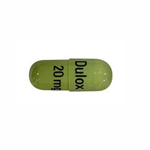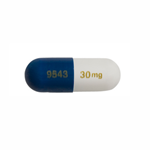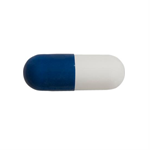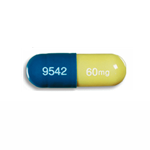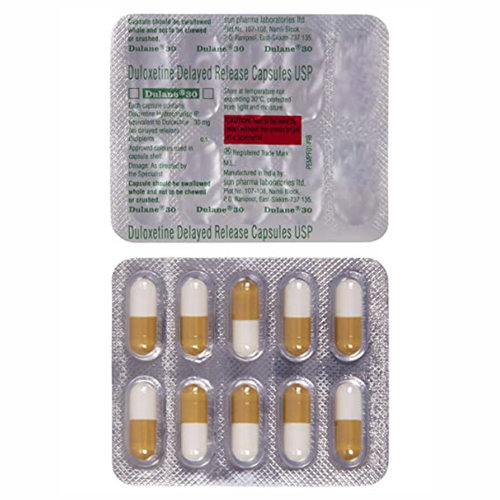
Buy Cheap Dulane® Duloxetine Online
- Brand: Dulane® Duloxetine Delayer Release Capsules USP
- Composition: Duloxetine
- Power: 20mg, 30mg, 40mg, 60mg
- Treatment: Depression, Anxiety, Fibromyalgia, Diabetic Peripheral Neuropathy
- Manufacturer: Sun Pharmaceutical Industries Pvt. Ltd.
- Country of Origin: India
Dulane® Duloxetine Capsules for Sale in Tadasiva.com
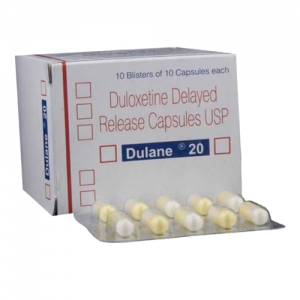
Dulane® 20 / 30 / 40 / 60 mg is a drug that has an antidepressant effect. Dulane® is an Indian Generic Cymbalta that contains duloxetine, a substance that is a combined inhibitor of norepinephrine and serotonin reuptake.
Duloxetine slightly inhibits dopamine uptake, has practically no affinity for histamine, cholinergic, dopamine and adrenergic receptors. The effectiveness of the drug in the treatment of depression is due to the inhibition of the reuptake of norepinephrine and serotonin, resulting in increased noradrenergic and serotonergic neurotransmission in the central nervous system.
Dulane® also has some analgesic effect, which, theoretically, is due to a decrease in the rate of transmission of pain impulses to the central nervous system.
- Packing: 10 Capsules in 1 strip
- Minimum order quantity: 30 Capsules
- Minimum price: $ 1.07 per Capsule
- : 14-21 days
- Trackable service: 5-9 days
- Order from $150.00: Free AirMail shipping
Dulane® 20mg Price
Dulane® 30mg Price
Dulane® 40mg Price
Dulane® 60mg Price
Overview of Dulane® Duloxetine tablets
Dulane® Duloxetine is used to relieve pain in various painful conditions, including diabetic neuropathy, fibromyalgia. Duloxetine is the most prescribed antidepressant in the United States (Generic Cymbalta).
Dulane® Duloxetine has a dual effect on both serotonin and norepinephrine. It has an FDA-registered indication – fibromyalgia (and this is a frequent manifestation of somatoform disorder). For some patients with anxiety disorders, switching from SSRIs to Dulane® improved their condition and quality of life (they called its effect “milder”).
- Elevated blood pressure is a common side effect of Dulane® Duloxetine due to vasoconstriction mediated by a suspected increase in norepinephrine signaling.
- Also, the effect of Dulane® Duloxetine on the spinal cord is associated with its modulation of pain. An increase in the concentration of serotonin and norepinephrine in the dorsal horn of the spinal cord increases the suppression of pain syndrome in descending order due to the activation of adrenergic receptors.
- Dulane® Duloxetine is a very good drug for the treatment of chronic pain syndrome with a depressive component, especially in combination with Gabapentin.
- Actually, the antidepressant effect seems to me quite weak. It is applicable in patients with narcological profile, after injuries of the musculoskeletal system, with diabetes mellitus.
How to take Dulane® Duloxetine?
Dulane® Duloxetine is taken orally, Capsules should be swallowed whole, without chewing or crushing. Do not add the drug to food or mix it with liquids, because this can damage the intestinal-soluble shell of pellets.
Dosage of Dulane® Duloxetine
Depression
The initial and recommended maintenance dose is 60 mg once a day, regardless of food intake.
In clinical studies, the safety of doses from 60 to a maximum dose of 120 mg / day was evaluated. However, there was no clinical evidence that patients who did not respond to the initial recommended dose showed any improvement with an increase in dose. The response to therapy is usually noted 2-4 weeks after the start of treatment. In order to avoid relapse after achieving a response to antidepressant therapy, it is recommended to continue treatment for several months. In patients who respond positively to duloxetine therapy, with a history of recurrent cases of depression, further long-term therapy at a dose of 60 to 120 mg / day is possible.
Generalized anxiety disorder
The recommended initial dose in patients with generalized anxiety disorder is 30 mg / day, regardless of food intake. In patients with insufficient response to therapy, it is possible to increase the dose to 60 mg / day, the usual maintenance dose in most patients. In patients with concomitant depression, the initial and maintenance dose is 60 mg / day. During clinical studies, the effectiveness of doses up to 120 mg / day was shown, in addition, such dosages were evaluated from the point of view of safety. Therefore, in patients with insufficient response to a dose of 60 mg, it may be advisable to increase the dose to 90 or 120 mg / day. Dose increases should be based on clinical response and tolerability.
In order to avoid relapse after achieving a response to therapy, it is recommended to continue treatment for several months.
A painful form of peripheral diabetic neuropathy. The initial and recommended maintenance dose is 60 mg once a day, regardless of the meal. During clinical trials, the safety of doses from 60 to a maximum dose of 120 mg/ day, divided into equal doses, was also evaluated.
The concentration of duloxetine in plasma is characterized by significant individual variability. Therefore, in some patients with insufficient response to a dose of 60 mg / day, improvements may be noted when using a higher dose. Evaluation of the response to therapy should be carried out after 2 months. In patients with insufficient initial response, improvement of the response after this period of time is unlikely. The therapeutic effect should be evaluated regularly (at least once every 3 months).
Chronic pain syndrome of the musculoskeletal system (including caused by fibromyalgia, chronic pain syndrome in the lower back and osteoarthritis of the knee joint)
Initial treatment
The recommended dose of Dulane® Duloxetine is 60 mg 1 time per day. Therapy can be started with a dose of 30 mg for 1 week to allow patients to adapt to the drug before increasing the dose to 60 mg once a day. There is no evidence that higher doses provide an additional benefit, even in patients who do not respond to therapy with the drug at a dose of 60 mg / day. Higher doses are associated with a high frequency of adverse reactions.
Continuation of treatment
The efficacy of Dulane® Duloxetine in the treatment of fibromyalgia has been demonstrated in placebo-controlled studies lasting up to 3 months. The efficacy of Dulane® Duloxetine has not been established in longer studies, however, the decision to continue treatment should be based on the individual response of the patient.
In patients with renal insufficiency:
with creatinine Cl 30-80 ml/ min, dose adjustment is not required, with creatinine Cl <30 ml / min, the use of the drug is contraindicated.
In patients with impaired liver function:
the drug should not be prescribed to patients with liver diseases that have led to liver failure.
Age
Elderly patients for the treatment of generalized anxiety disorder are recommended an initial dose of 30 mg for 2 weeks before starting the use of duloxetine at a target dose of 60 mg / day. In the future, it is possible to use the drug at a dose of more than 60 mg / day to achieve a good result. Systematic evaluation of the drug intake at a dose of more than 120 mg / day was not carried out. When using duloxetine for other indications, dose adjustment depending on age is not required.
It is recommended to use the drug in patients ≥ 18 years of age. Duloxetine is not recommended for children under 18 years of age due to insufficient data on its safety and efficacy in this age group of patients.
Abrupt discontinuation of therapy should be avoided
Upon discontinuation of treatment with duloxetine, the dose should be gradually reduced for 1-2 weeks in order to reduce the risk of “withdrawal” syndrome. If, after dose reduction or after discontinuation of treatment, pronounced symptoms of “withdrawal” syndrome occur, then continuation of the previously prescribed dose may be considered. Subsequently, the doctor may continue to reduce the dose, but even more gradually.
Contraindications of Dulane® Duloxetine
Dulane® Duloxetine is contraindicated in the therapy of patients who do not tolerate the active or auxiliary components of capsules.
Contraindications to the use of the drug Dulane® Duloxetine are also:
- Unstable hypertension (considering the risk of hypertensive crisis).
- Impaired renal function (with filtration rates below 30 ml/min).
- Pathology of the liver.
- The use of duloxetine is strictly contraindicated in patients receiving therapy with irreversible non-selective MAO inhibitors (taking duloxetine is also prohibited for 2 weeks after the end of therapy with such drugs, therapy with monoamine oxidase inhibitors can be started no earlier than 5 days after the end of taking duloxetine).
In addition, duloxetine is contraindicated against the background of therapy with fluvoxamine, enoxacin and ciprofloxacin (given the significant effect of these drugs on CYP1 A2). - Dulane® Duloxetine is not used in pediatrics.
It is necessary to prescribe duloxetine with caution to patients with a tendency to suicide (such patients should be under constant supervision, because suicide attempts at the beginning of therapy are not excluded).
In addition, the drug Dulane® Duloxetine is prescribed with caution when:
- Epileptic seizures, bipolar disorders and mania (including a history).
- Increased intraocular pressure and the danger of acute narrow-angle glaucoma.
- Arterial hypertension, heart pathologies and cardiac arrhythmias.
- Increased risk of hyponatremia.
- Taking drugs that have a hepatotoxic effect.
With duloxetine therapy, potentially dangerous types of equipment should not be controlled.
Side Effects of Dulane® Duloxetine
Against the background of Dulane® Duloxetine therapy, such undesirable effects may occur in patients:
- Nervous system: agitation, sleep disorders, anxiety, abnormal orgasm, visions, bruxism, orientation disorders, suicidal thoughts, apathy, aggression, hallucinations, mania. In addition, tremors, paresthesia, attention and memory disorders, taste changes, dyskinesia, lethargy, seizures, serotonin syndrome and extrapyramidal disorders may occur.
- Sensory organs: visual disturbances, mydriasis, dry eyes, glaucoma, pain and ringing in the ears.
- Heart and blood vessels: tachycardia, atrial fibrillation, supraventricular arrhythmia, palpitations, hot flashes, loss of consciousness, as well as orthostatic hypotension, lability of blood pressure, cold extremities, hypertensive crisis.
- Respiratory system: nosebleed, sore throat, yawning, feeling of tightness in the throat.
- Digestive system: hyperglycemia, anorexia, stool disorders, vomiting, dyspeptic phenomena, abdominal pain, increased gas formation, bleeding of the gastrointestinal system, belching, gastritis, gastroenteritis, bad breath, stomatitis, blood in the stool.
- Liver: acute liver damage, hepatitis, increased liver enzymes, liver failure, jaundice.
- Urinary system: urinary retention, dysuria, polyuria, nocturia, slowing of urine flow, change in urine odor.
- Reproductive system: menstrual disorders, erectile dysfunction, delayed ejaculation, uterine bleeding, galactorrhea, signs of menopause, hyperprolactinemia.
- Allergic reactions: rash, sweating, angioedema, contact dermatitis, urticaria, photosensitivity, Stevens-Johnson syndrome, anaphylactic shock.
- Others: laryngitis, hypothyroidism, insufficiency of antidiuretic hormone, hyponatremia, increased risk of bruising, pain in bones and muscles, muscle spasm and trembling, trism.
Contents
- 1 Buy Cheap Dulane® Duloxetine Online
- 2 Dulane® Duloxetine Capsules for Sale in Tadasiva.com
- 3 Dulane® 20mg Price
- 4 Dulane® 30mg Price
- 5 Dulane® 40mg Price
- 6 Dulane® 60mg Price
- 7 Overview of Dulane® Duloxetine tablets
- 8 How to take Dulane® Duloxetine?
- 9 Dosage of Dulane® Duloxetine
- 10 Contraindications of Dulane® Duloxetine
- 11 Side Effects of Dulane® Duloxetine

